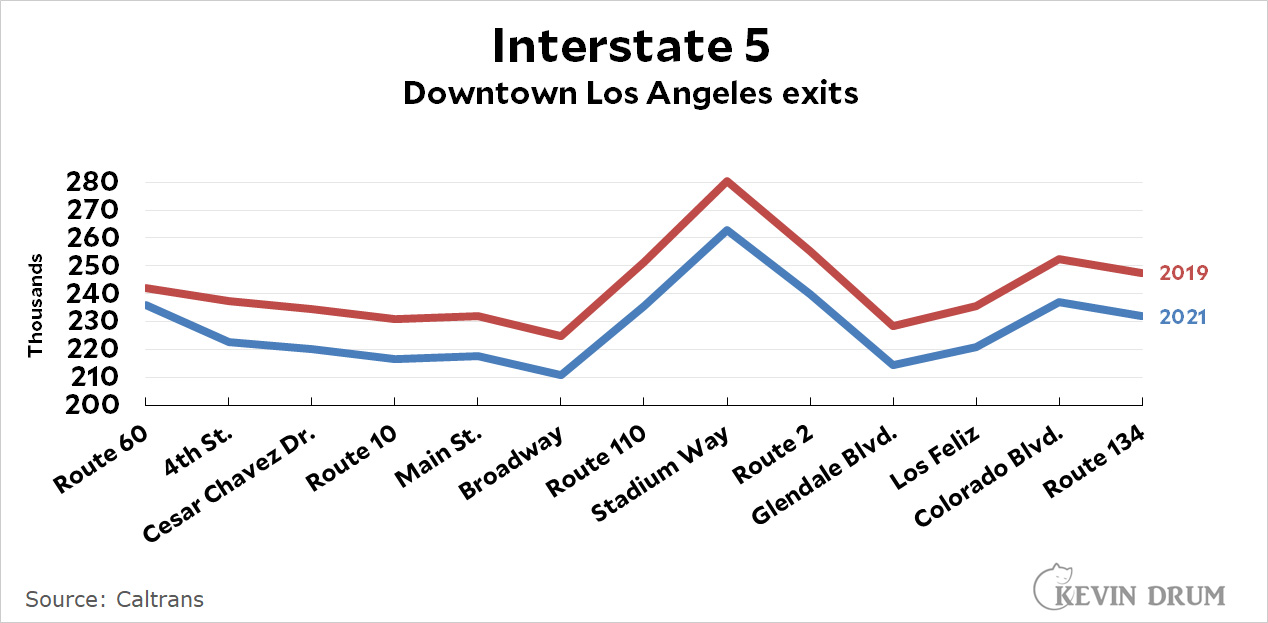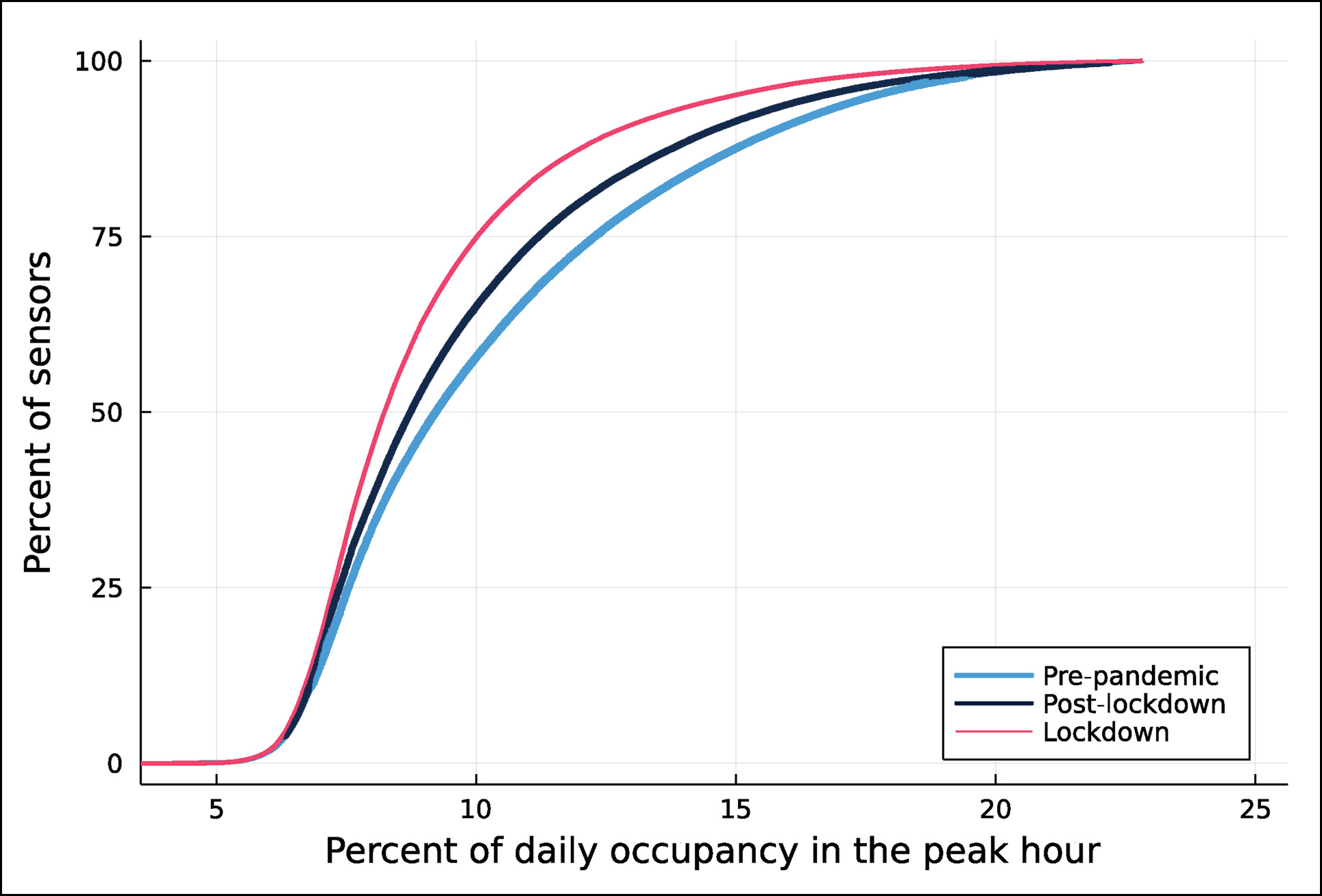Today at lunch the topic of traffic came up. If lots of people are working at home these days, shouldn't commuting traffic in cities be down considerably? I said I'd check, but that turns out not to be easy. Here's one data point:
 This is national data and it shows no change whatsoever in urban traffic before and after the pandemic.
This is national data and it shows no change whatsoever in urban traffic before and after the pandemic.
Next I headed over to Caltrans to see what kind of data they had for Los Angeles. Lots, it turns out, but only through 2021. Still, that would be suggestive, so I pulled up all the downtown LA exits from Interstate 5:
 The year 2021 was a peak for remote work, but traffic was down only 6%.
The year 2021 was a peak for remote work, but traffic was down only 6%.
This gibes with personal experience: namely that rush hour traffic seems just as jammed today as it was a few years ago. But is it really? Apparently so. Here is Martin Morzynski, an executive at Streetlight, a traffic analytics firm:
Despite empty offices, rush hour congestion is back, with key streets leading in and out of our downtowns clogged again.
A recent study of California traffic suggests that although overall volume is nearly back to normal, peak travel has been spread out:
During the pre-pandemic peak hour, the occupancy during the peak hour is high, indicating congestion....Post-lockdown, spreading of the peaks has somewhat decongested rush hour. Even though the peaks have spread out, the reduction of gridlock has enabled a larger portion of daily vehicles to successfully transit the intersection during the peak hour.
I'm a little baffled about what this chart shows, but one thing is obvious: there's not a big difference between pre-pandemic and now. The authors claim that the share of traffic occurring at peak hours is down from 10.3% to 9.8%, but they themselves are a bit puzzled by this, since it's not clear why peak traffic should be down if total traffic has stayed the same.
Overall, the evidence suggests that urban traffic has barely changed since before the pandemic, despite the fact that the occupancy rate of downtown office towers has plummeted to around 50%. This is a considerable mystery. If lots of people are staying home instead of commuting to those towers, why hasn't traffic subsided?


All Five Guys at the Algonquin roundtable, Wendy, the Burger King, Kevin, In & Out.
Overall, the evidence suggests that urban traffic has barely changed since before the pandemic, despite the fact that the occupancy rate of downtown office towers has plummeted to around 50%. This is a considerable mystery.
According to a quick google, office occupancy (non-vacancy) in the US is around 82%. Perhaps not exactly what Kevin is referring to, but still. And how many workers in the US are in classic "WFH" friendly occupations? We're talking about high(ish) end knowledge workers. Twenty percent? Thirty percent? Even fully a 1/3rd decrease in commuting from such workers would only translate nationally into perhaps a 7-10% dip in traffic from this source, and that might be partly counteracted by increases elsewhere (say, more traffic from delivery vans). Plus, although more slowly than in the past, the population is growing: there are likely several million more working age Americans now than in 2019.
Also, many office workers in "urban" American don't work in the CBD. Plenty work in secondary business districts or in office parks. And needless to say, many, many types of work aren't amenable to work-from-home (I was just reading an article in the Boston Globe about that metro's transit woes: there's lots of worries it will be harder to attract top talent in the bio-pharma sector, because those folks have to get to the lab, and subway dysfunction is killing them!). Then add in hospital workers, teachers, hotel workers, retail workers...
but they themselves are a bit puzzled by this, since it's not clear why peak traffic should be down if overall traffic has stayed the same.
The same technologies that allow an increase in WFH also allow greater flexibility (ie, work from home until 10 am, then drive in to the office, then come home at 2:45pm, all to avoid traffic).
traffic follows the goldfish effect: it expands to fill the space its given (aka induced demand). people used to avoid some highways at certain times because they were congested with commuters. now they take other trips during those times, so the highway is nearly as full. this is why adding a lane never permanently fixes traffic: people just take more trips and use up the capacity.
1. People are still driving, they just aren’t driving to an office. They’re going to Starbucks, lunch, errands, whatever, instead.
2. Transit ridership still hasn’t recovered. All those people who used to ride transit might be driving now, offsetting the fewer trips made by people who always were driving.
3. Everybody at home is having everything delivered. And instead of all those items being picked up in one shopping trip, they’re all being delivered individually at your house. So that trip you used to make to Target or wherever to buy 50 items instead is replaced by maybe 5 trips from various online services of 10 items each to your home, because of course all the items aren’t necessarily in stock at the same warehouse at the same time. (Amazon Prime in particular has resulted in my friends getting multiple deliveries every single day, often with just 1-2 items in each box.)
Also: a lot more parents than when I was in school drive their kids to school. Even if they aren’t going into an office, they’re probably still driving their kids to school… and schools basically have the same hours as offices. (8-3 instead of 8-5.) So it’s entirely possible that a good half or more of the “I work from home” crowd still has to drive a bunch of miles between 7-9am and again between 2-5pm (depending on after school activities).
You've never noticed the difference in rush hour traffic during the school year and when school is out?
You're barking up the wrong tree, KD.
Check the public transportation stats, instead. Start here with Trimet's annual ridership data.
Less efficient traffic.
Carpools and mass transit was decimated.
More deliveries, with even UPS and FedEx plus Amazon and others now multiplying their own deliveries.
As others have said it's all about public transit which is way down. People switched to cars.
"This is a considerable mystery. If lots of people are staying home instead of commuting to those towers, why hasn't traffic subsided?"
Thank you for getting to the end of the post and then sorta realizing the post itself didn't actually get anywhere and shrugging "well, I still got a post out of it".
Pingback: The remote work mystery deepens—traffic is worse than ever but offices are sitting empty - Buzz4All
Pingback: The remote work mystery deepens—traffic is worse than ever but offices are sitting empty - Canada Boosts - Happy Boosts Canada
Pingback: The remote work mystery deepens—traffic is worse than ever but offices are sitting empty - FT News
Pingback: The remote work mystery deepens—traffic is worse than ever but offices are sitting empty - Vip News Today
Pingback: The remote work mystery deepens—traffic is worse than ever but offices are sitting empty - Hawaii Digital News
Pingback: The remote work mystery deepens—traffic is worse than ever but offices are sitting empty
Pingback: The remote work mystery deepens—traffic is worse than ever but offices are sitting empty – LSD News
Pingback: The remote work mystery deepens—traffic is worse than ever but offices are sitting empty - asiabusinessalert.com
Pingback: The distant work thriller deepens—visitors is worse than ever however places of work are sitting empty - Worldwide News
Pingback: The mystery of remote work deepens - traffic is worse than ever but offices sit empty - lineup-mag
Pingback: The distant work thriller deepens—site visitors is worse than ever however workplaces are sitting empty - DontWorryBuy
Pingback: The remote work mystery deepens—traffic is worse than ever but offices are sitting empty – Jpnews
Pingback: The remote work mystery deepens—traffic is worse than ever but offices are sitting empty | News Scrap
Pingback: The remote work mystery deepens—traffic is worse than ever but offices are sitting empty - Digital Info Center